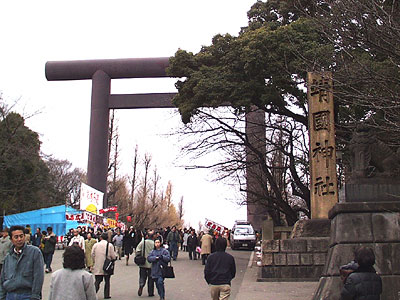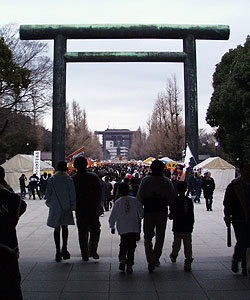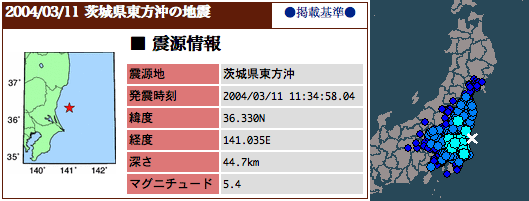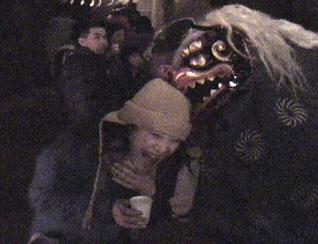 Prime Minister Junichiro Koizumi visited Yasukuni Shrine on New Year’s Day, something referred to as Hatsumode in Japan, visiting a shrine to pay one’s respects and to pray at the outset of the new year (I just did that myself–I’ll blog on it as soon as I get the video on to my computer). Koizumi’s visit is classed as an “official visit,” which somehow apparently makes it a political act instead of a religious one, which would violate the separation of church and state here.
Prime Minister Junichiro Koizumi visited Yasukuni Shrine on New Year’s Day, something referred to as Hatsumode in Japan, visiting a shrine to pay one’s respects and to pray at the outset of the new year (I just did that myself–I’ll blog on it as soon as I get the video on to my computer). Koizumi’s visit is classed as an “official visit,” which somehow apparently makes it a political act instead of a religious one, which would violate the separation of church and state here.
Now, one might think that the prime minister visiting a shrine on New Year’s might be kind of like a U.S. president going to church on Christmas, and normally you’d be right; it’s just the choice of shrines that makes the difference. Imagine, for example, that a U.S. president visited a church that advocated white supremacy, and that it was not just one president or one time, but a string of presidents visiting the same church for more than a quarter century.
That’s kind of like what’s happening here in Japan. Yasukuni Shrine (English site), originally called Tokyo Shokonsha, was built in 1869 at the time of the Meiji Restoration, when the Tokugawa Shogunate collapsed and the Emperor was, at least nominally, reestablished as the head of the country in a constitutional monarchy with a parliament (“Diet”). Yasukuni was run by the military as a shrine for the fallen soldiers of national wars, and after WWII, many soldiers of that war were enshrined there–but in 1978, fourteen class-A war criminals from WWII, including wartime prime minister Hideki Tojo, were interred there as well. Since that time, Yasukuni has displayed exhibits extolling the virtues of the war dead, and has taken somewhat of a  nationalistic view of Japan’s actions during that period of time (one example is that WWII is referred to by the shrine as the “Greater East Asian War,” a name used by nationalists who rationalized the war as a movement to free Asia from European rule; other examples include the reverence paid to the war criminals and the shrine’s attitude that the war crime tribunals were a “sham”).
nationalistic view of Japan’s actions during that period of time (one example is that WWII is referred to by the shrine as the “Greater East Asian War,” a name used by nationalists who rationalized the war as a movement to free Asia from European rule; other examples include the reverence paid to the war criminals and the shrine’s attitude that the war crime tribunals were a “sham”).
And there’s where the problem arises: the shrine kind of represents Japan’s reluctance to see WWII as a war of Japanese aggression, but rather as a justified war, a view in which the suffering by Japanese people and soldiers is emphasized and the atrocities committed by Japan are either de-emphasized or completely whitewashed and denied. In 1975, prime minister Miki visited the shrine, followed by Fukuda in ’78–after which the war criminals were enshrined. Then PM Suzuki visited in 1980, and Nakasone in 1983, ’84, and ’85–after which he stopped, due to the magnitude of protest from abroad, primarily from China and South Korea. Things were quiet until 1996, when Ryutaro Hashimoto visited again. In 1999, there was an attempt to band-aid the controversy by removing the war criminals, but the shrine refused to do so. (An excellent chronology of events can be found here.)
Koizumi sparked the controversy anew in 2001 when he visited the shrine, and has now done so four times since. Most visits by prime ministers have been in August during the O-bon season, in which the dead are honored; to my knowledge, this is the first New Year’s visit.
The aspect that sticks out here is that Yasukuni seems to be the shrine of choice for these prime ministers (we’re overlooking numerous visits made by other government officials); there is certainly no shortage of shrines to visit, and then there is the possibility of simply not visiting a religious institution at all. But the fact that so many prime ministers have chosen this particular shrine (instead of the more famous and innocuous Meiji Shrine, for example) seems to indicate a high-level endorsement of the nationalistic view of Japan’s wartime role–and at a time when Japan is beginning to assert a military presence overseas and is considering repealing the postwar constitution’s article on a defense-only military and the renunciation of war… well, one can see the objections that might be raised. Yes, Yasukuni is the memorial to almost all of Japan’s war dead since the shrine was erected, about 2.5 million Japanese, so it is a sort of Arlington National Cemetery. One might expect some nationalism if you regard it that way, but Japan’s history is different, and its refusal to apologize formally and definitively, make sincere reparations and take on a national attitude of remorse and disapproval for the nation’s actions (more like Germany has done) makes Japan’s situation a unique one.
The bright side to this is that there is no ongoing violence in this vein, so it is possible that Japan’s role in WWII and the decades preceding may be forgotten and forgiven over time. However, visits like Koizumi’s a few days ago are certainly not helping things much.



 Historically, Japan has been a smoker’s paradise. Whatever concessions that were made for non-smokers was superficial, at best, and many times they still are. For example, not long ago I stopped at a McDonald’s for a quick lunch. I was told that in the seating area, there was a non-smoking section–but before I even got there, I knew what I would find. And sure enough, the “no smoking” section was three small tables at the back end of the room (almost always opposite from the windows), and not more than five feet from several other tables filled with smokers, with no air currents favoring the no-smoking area. When I left a half hour later, my clothes and hair smelled like an ashtray.
Historically, Japan has been a smoker’s paradise. Whatever concessions that were made for non-smokers was superficial, at best, and many times they still are. For example, not long ago I stopped at a McDonald’s for a quick lunch. I was told that in the seating area, there was a non-smoking section–but before I even got there, I knew what I would find. And sure enough, the “no smoking” section was three small tables at the back end of the room (almost always opposite from the windows), and not more than five feet from several other tables filled with smokers, with no air currents favoring the no-smoking area. When I left a half hour later, my clothes and hair smelled like an ashtray.
 One of the nice things about living where I do is that the neighborhood is very nice. I’m just 45 minutes from downtown Tokyo by train, but the town I live in is open, spacious and green. Lots of parks, great view from where I live. There are drawbacks, however–fewer stores, and my place is a good distance from the train station, so I have to depend on buses, and they usually are not very convenient.
One of the nice things about living where I do is that the neighborhood is very nice. I’m just 45 minutes from downtown Tokyo by train, but the town I live in is open, spacious and green. Lots of parks, great view from where I live. There are drawbacks, however–fewer stores, and my place is a good distance from the train station, so I have to depend on buses, and they usually are not very convenient.

 Every year at New Year’s Eve, I go to a local shrine–somewhat of a private tradition since I first came to Japan. I really enjoy the people, the music, the local atmosphere, the free sake. One year (on the millennium, in fact) I spent New Year’s back home in the U.S., but everyone went to bed at 11 pm, and I just sat there watching Dick Clark on TV and thought, hey! I could be at a shrine right now!
Every year at New Year’s Eve, I go to a local shrine–somewhat of a private tradition since I first came to Japan. I really enjoy the people, the music, the local atmosphere, the free sake. One year (on the millennium, in fact) I spent New Year’s back home in the U.S., but everyone went to bed at 11 pm, and I just sat there watching Dick Clark on TV and thought, hey! I could be at a shrine right now! everything else, too. The sake (including kids’ sake, non-alcoholic and, to me, really bad-tasting), a traditional band, the shishi-mai dance, a nice bonfire, with nice trinkets, charms and arrows (for luck) on sale. The works.
everything else, too. The sake (including kids’ sake, non-alcoholic and, to me, really bad-tasting), a traditional band, the shishi-mai dance, a nice bonfire, with nice trinkets, charms and arrows (for luck) on sale. The works.

